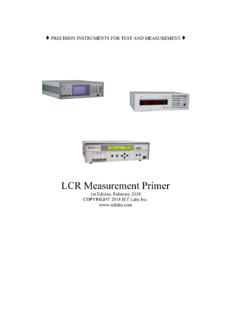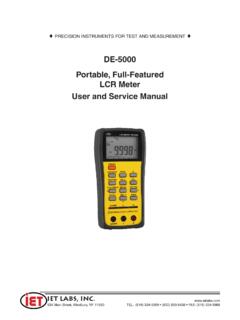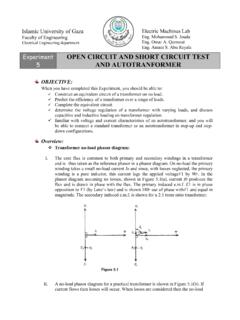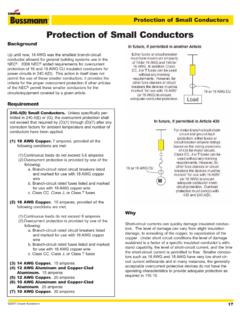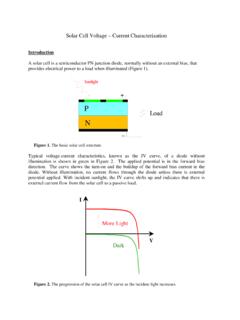Transcription of Characteristic Cable Impedance - Iet Labs
1 534 Main Street, Westbury NY 11590 P: 516-334-5959, 800-899-8438 Application Note Characteristic Cable Impedance Characteristic Cable Impedance (Zo) is a very important measurement in determining a Cable s transmission capability. Maximum power is transmitted when the source has the same Impedance as the load. Therefore the Cable (line) should have the same Characteristic Impedance as the transmission equipment. The Zo of the transmitting equipment drives the maximum signal into the line and in turn the Zo of receiving equipment determines the maximum signal out of the line. Ideally, ZoTRANSMITTER = ZoLINE = ZoRECEIVER. When the Characteristic impedances do not match, part of the signal is reflected back to the source degrading the transmission path. Figure 1: Maximum Signal Transmission Although it can be represented in terms of inductors, capacitors and resistors, Characteristic Impedance is a complex number that is highly dependent on the frequency of the applied signal.
2 Zo is not a function of the Cable length. At high frequencies (> 100kHz), the Characteristic Impedance is almost purely resistive. At mid-range frequencies (1kHz), Zo is affected by capacitance ( C) and at low frequencies (DC 100Hz), Zo is influenced by conductance (G). Refer to Figure 2. TransmitterReceiverCoaxial CableLineVoltage Input (VI)Incident waveVoltage Reflected (VR)Reflective waveLoadSourceZoTRANSMITTERZoLINEZoRECEI VERM aximum Signal Transmission (power transfer) occurs when ZLINE = ZLOAD Figure 2: Characteristic Impedance Formulas Measuring Characteristic Cable Impedance Yet, how does a Cable manufacturer realistically measure the Characteristic Impedance of his product? In other words, what is the Cable s Zo, the ZLINE that must be equated to the transmitter and receiver? The Characteristic Impedance of coaxial Cable can be determined from the formula: ZO is the Characteristic Impedance ZOC is the Open circuit Impedance ZSC is the short circuit Impedance To measure a coaxial Cable (in the frequency range 12Hz to 200kHz) on the 1693 Digibridge: 1.
3 Connect the Cable via 7000-03 leads or fixture to the 1693 front panel output terminals. 2. Perform OPEN / short zeroing on the 7000-03 leads (or your fixture). 3. Attach the Cable to the 7000-03 leads (or your fixture) and measure ZOC. 4. short the Cable ends and measure the ZSC ( Cable short circuited). 5. Calculate ZO from the formula above. f = DC - 100 Hzf = 1kHzf = 100kHzfrequency:Zo:Zo =RGZo =LCZo =R CZo =ZocZscZo =R+ j LG+ j CComplex EquationResistive MeasurementZO=ZOCZSCQuadTech1693 RLC DigiBridge Hk SDEGNOT 1kHzRANGE HELDCONST GOGOBIASONEXTERNALBIASREMOTECONTROLOnOff SEROnOffCONST (Or leads: Shown = 7000-03 BNCto Kelvin Leads) Cable ends Apart = ZOCC able endsShortedTogether = ZSCS hortOpen1693 DigibridgeConductorDielectricCoreBraided ShieldJacketCoaxial CableBraided ShieldConductorDielectricCoreJacketCoaxi al CableBraidedShieldBraided Shield Figure 3: Coaxial Cable Impedance Measurement with 7000-03 Kelvin Leads Zoc is made with the Cable ends apart by connecting the red Kelvin lead to the conductor and the black Kelvin lead to the braided shield.
4 Similarly, Zsc is made with the same connection, except the Cable ends are shorted together. For complete product specifications on the Digibridge Line of LCR meters or any of IET s products, visit us at Do you have an application specific testing need? Call us at 1800-899-8436 or email engineering at and we ll work with you on a custom solution. Put IET to the test because we re committed to solving your testing requirements.

